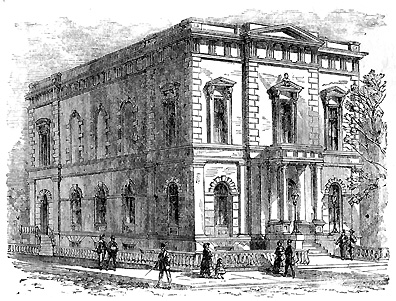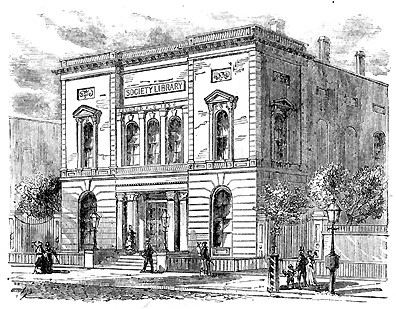|
|
Chapter IV
New York As It Is.
The Libraries, Monuments and Markets of New York A. Description of the Island.—
B. Population at Different Periods.—
C. Streets and Avenues.—
D. Architecture of Manhattan—
E. Business in New York—
F. Churches of New York—
G. Parks and Squares.—
H. How New York is Supplied with Water.—
I. The Schools and Colleges of New York.—
J. Public Security—
K. New York All the Year Round—
L. The Libraries, Monuments and Markets of New York—
M. The Cemeteries of New York.
The Libraries
The Libraries—
The Monuments—
The Markets.
 New York Historical Society—Second Avenue, cor. Eleventh Street. THE libraries of Manhattan far excel those of any other city on the continent. The first public library was established in 1729, when Rev. John Millington, Rector of Newington, England, bequeathed 1622 volumes to the "Society for the Propagation of the Gospel in Foreign Parts." Rev. John Sharp, chaplain of Lord Bellamont, having some years previously presented a collection of books, they were now arranged and offered for the public use under the title of the "Corporation Library." But the librarian soon died, and the library was neglected. In 1754, a few enterprising minds organized the "Society Library," and by grant of the Common Council, added this old library to their own collection. The society was chartered by George III. in 1772, and still flourishes with a library of about 50,000 volumes.  Mercantile Library—Clinton Hill. (Astor Place and Eighth street.) "THE YORK HISTORICAL SOCIETY," which has done more than any other to preserve the reminiscences of early New York, was found in 1804. Its rooms contain, besides the library, many choice and rare curiosities. "THE MERCANTILE LIBRARY ASSOCIATION" has held its fiftieth anniversary, and is, perhaps, the most popular institution of its kind in the city. It owns its fine edifice, Clinton Hall, on Astor Place, has a property valued at half a million, and a library of one hundred and twenty thousand volumes, which increases at about ten per cent. per annum. Its reading-room contains four hundred paper and magazines.  New York Society Library—At University Place. THE "ASTOR LIBRARY" is the largest in New York, and contains one hundred and thirty-five thousand volumes, mostly solid works. It is emphatically the great library of reference for scholars, and fills an important place in the literary facilities of the metropolis. The cut presents a view of the original structure, as provided for by the bequest of John Jacob Astor, but which has been enlarged by his son, William B. Astor. The present building and library form a worthy monument of two worthy men. Besides these we may mention the "Apprentices' Library," of fifty thousand volumes, the "Library of the American Institute," the "New York City Library," the "Printers Free Library," the "Women's Library," the "Harlem Library," the "Mott Memorial Medical Library," the "New York Law Institute Library," and the immense libraries connected with the large institutions of learning. Honorable Peter Cooper has also during this year, on the occurrence of his eightieth birthday, surprised the community with the gift of $150,000, to found a complete library for working men. To these will, also soon be added the "Lenox Library," founded by the distinguished philanthropist whose name it bears, who has just set aside land and $300,000 for the erection of appropriate buildings, opposite Central Park, to which he adds his entire collection of statuary, paintings, and books, said to be the most valuable in the country, and money sufficient to make it complete and unrivaled. Besides these, there are numerous reading-rooms judiciously distributed through the city, furnished with all the periodical literature of the day, opened by the Young Men's Christian Association, and other benevolent societies. |
|
118
:: Previous Page :: Next Page ::
Books & articles appearing here are modified adaptations
from a private collection of vintage books & magazines. Reproduction of these pages is prohibited without written permission. © Laurel O’Donnell, 1996-2006.
|
|

